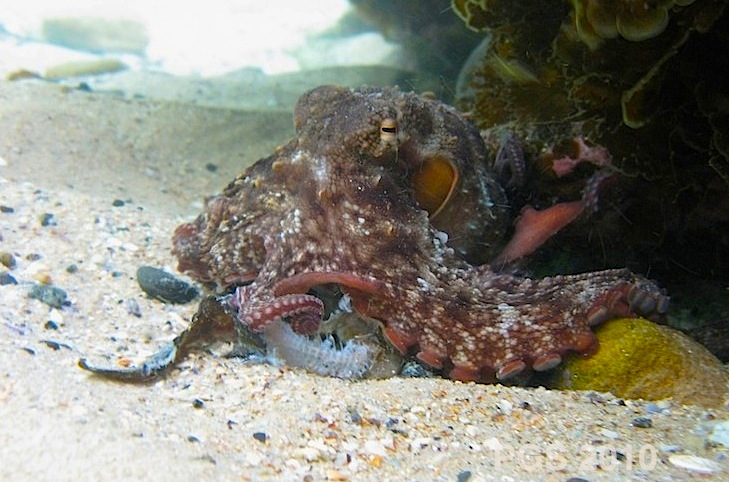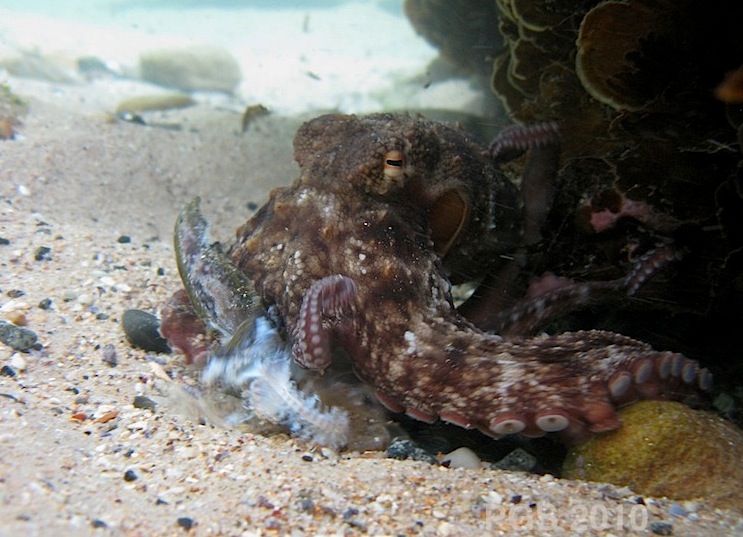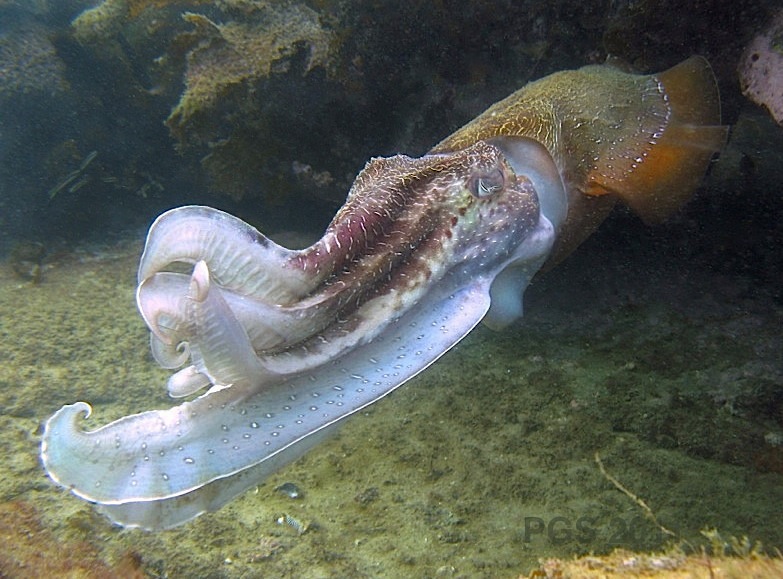The octopus photos in this post are from a couple of years back, when I came across an octopus devouring the remains of a fish. I don’t know if the octopus caught the fish, or was scavenging. Either way, the octopus was very enthusiastic and there was not much left of the fish.
This post, though, is written from trains in France and Belgium, zooming through farmland. Some months back I wrote on this site about eating animals, vegetarianism, and humane farming. I don’t have a problem with carnivory per se, but oppose the cruelty of much modern farming. One set of comments came from Christiane Bailey, who doesn’t think that a distinction between standard and “humane” farming makes much difference here. She put up some information in support. One thing that stayed with me was some data on the lifespans of animals farmed for food. According to the chart, animals bred for food live just small fractions of their natural lifespan – for pigs, 6 months; for ducks, 7-8 weeks. If the position of the previous post was that if we are to farm animals then we should give them a decent life, then there is a constraint to think about here: the good part of that life cannot be too short.
Not long after that discussion, I drove through farmland near San Gregorio, in Northern California. The cows hanging out there in the gentle Californian sun looked completely content. I guess they might have been quite young, despite their size, but I found myself thinking that we had not done so badly by those cows, even though their end – like nearly everyone’s end – was not going to be pleasant. And watching the countryside from the train here, a lot of cows are looking very content also. Unless I don’t understand the hidden lives of the San Gregorio and French cows at all, this seems long way from an industrialized drug-drenched American feedlot, and far from the horrors of Australian “live export,” where animals are crammed in suffocating ships to middle-eastern and asian countries for brutal slaughter in accordance with archaic religious rules.
Here in France one menu included “suckling pig.” This led to some thought and discussion. On one side, there is the fact that pigs by all accounts are intelligent and rather charming animals. Can’t we stop being so cruel to them? On the other side, those animals would not exist at all without farming. The remaining scraps of wilderness would contain a few boars and sows, leading very different lives, and that would be it for the pigs. I take it that quite a few people who work on animal rights at the moment think this is the right goal (see here and here). We should retire the last generations and have no more. They think that exploitation is just not what we should be doing to animals, and “humane” exploitation is still just exploitation. I see the force of what they are saying, but find myself thinking that “exploitation” is not the right category to use when sorting through this problem. And even if it was possible to eradicate the use of animals for food, leading to the disappearence of pigs and the San Gregorio cows, I am not sure that this is best option, even as an ideal. However, one good principle might be to stop eating mammals (at least) at such a young age that there is not enough of a life there for the life to be worth living – we should not eat them so young they have no chance of a good number of those San Gregorio cow days.
Then suckling pigs are definitely off the menu. Along with various other things.
The last picture below is unrelated. I mentioned in the previous post the competitive stretching of male Giant Cuttlefish, to display to each other. I linked to one of the better photos I have of the display. “Better” there referred to the animal – the photo itself shows its low light and murky water. The photos on this site are only minimally modified, if at all – some are cleaned up to get rid of floating specks of sand, and some are brightened, sharpened a bit, or have their “white point” adjusted.** This photo, though, I did more work on, for a better image of a cuttlefish grand stretch.
______________
* Nicholas Kristof wrote a good column about animal welfare, especially the problem of factory farming, today (7/28/13) in the New York Times. And here is another Times story (7/30/13) about the effects of factory farming on the spread of dangerous drug-resistant bacteria in humans.
And here is a very good article I just came across about humane slaughter.
** Except for the GoPro frames – those ones have been re-worked much more.




I do eat meat, although not a lot. Perhaps as bad though is eating dairy products because of the ways cows are turned into milk machines, yet I drink milk. My conscience has been more pricked this week however by participating in a mass science project in the UK, the Flying Ant Survey https://www.societyofbiology.org/get-involved/biologyweek/flying-ant-survey
While I value the opportunity to take part, this year it involves catching ants & sending them to be assessed which will probably mean their death. What right do I have to deprive an ant of its evolutionary ‘purpose’ – reproduction. And yet I have! How strange to feel that for an ant & not for the cow, well not in the same way…
The gestalt-switches that occur in this area are very interesting, including among people working routinely with the killing of animals. This interview — http://boingboing.net/2012/03/08/working-undercover-in-a-slaugh.html — is well worth reading. It’s about the experience of working in a slaughterhouse, and the attitudes of the other workers to violence. In the ant case you describe, there is also the question of the relation between suffering and depriving an animal of the chance to reproduce. The latter does not bother me, as I think evolutionary ‘purposes’ in the sense that is relevant here don’t have moral importance — though I do feel a little hint of what you describe.
Not so long ago, I used to think that there were ways of farming animals which were humane and respectful of the basic needs, interests and preferences of animals themselves.
After much research, I had no other choice, but to change my mind and admit that the exploitation of animals for their meat, their milk or their eggs inherently implies many kind of violence towards them.
The humane myth (the belief that we can breed animals for their meat, milk, eggs, skin and fur in a way which would respect their most basic interests) is a very powerful, but deceiving narrative insofar as we do not even intend to respect their most basic interests to bodily integrity, to move freely and to live.
We even talk of “humane slaughter” as if we were euthanizing old and sick animals out of compassion.
You are right about the fact that the life of a dairy cow is very different from the life of beef cattle in concentrated feedlots. But that sadly doesn’t mean that the life of a dairy cow is much better.
The exploitation of cows for their milk implies a violence which is often invisible and/or carefully hidden.
Farming female mammals for milk involves getting the cows pregnant through artificial insemination each year or so and stealing their babies at birth (ranging from a couple of hours to 3 days).
The separation causes extreme stress on both as the mother/calf bond is very strong.
Cows, like most female mammals, have a strong impulse to take care of their young and depriving them of this very basic possibility can hardly be considered « humane ».
If the calf is a male, he will most likely be fattened for veal, after having lived a very short and lonely life.
If the calf is female, she might become a dairy cow, like her mother. When she will be around 13 months of age, she will be artificially inseminated. Her newborn calf will be quickly stolen and this scenario will repeat itself 3-4 times before her production declines and she gets sold for her meat and slaughtered too.
The transportation to slaughterhouses itself is known to be very a painful and frightening experience for these animals.
No matter how supposedly « humane » is the exploitation of animals, it will involve violence towards animals. These violence cannot be considered necessary in any sense of the word insofar as we can thrive on a vegan diet. Our health and the environment would also greatly benefit from it (according to the UN, livestock contribute more to climate change than all transportation and play a major role in water depletion).
You make a lot of good points, Christiane. As you say, less obvious forms of stress, such as those arising from the separation of mothers and calves, are important to consider. The issue is not just basic physical maltreatment.
The cows I was thinking about in my my post were beef cows rather than dairy, I think – in the Californian case at least, they looked like an ‘Angas’ sort of breed. But I consume a lot of dairy products, most of which probably use milk produced with standard farming methods. So there is a problem here.
I wonder, though: is your goal to bring to a complete end the ‘farm animal’ way of living? If exploitation of animals is intrinsically bad, then I take it there is no degree of care in their treatment that would justify their farming?